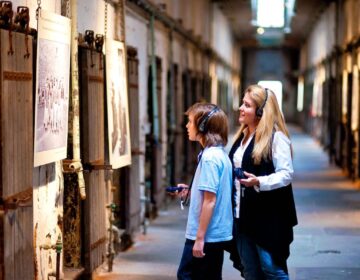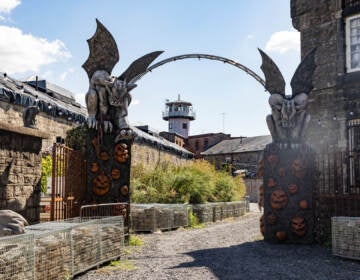History behind the walls: How Philadelphia’s most famous haunted house began
The grounds of Eastern State Penitentiary survived years of abandonment and bids for redevelopment. There’s just as much history as there is terror behind those walls.
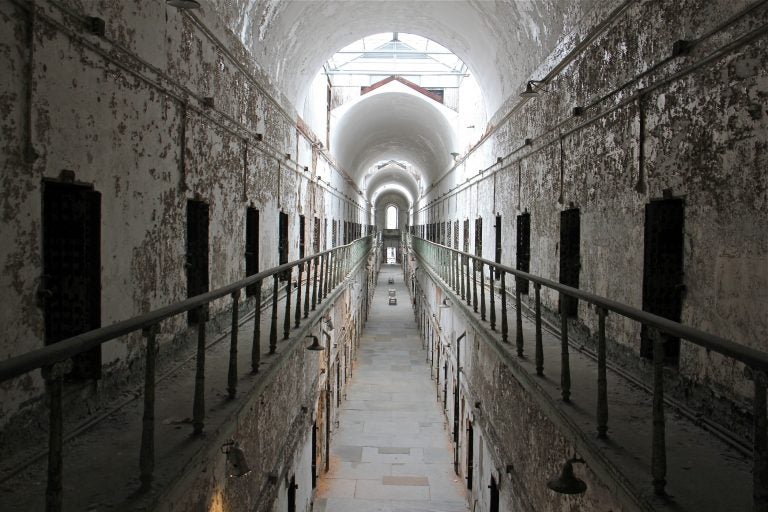
Eastern State Penitentiary. (Emma Lee/WHYY)
Walk by 2027 Fairmount Avenue on any weeknight in October, and the shrieks will probably stop you in your tracks.
For nearly 30 seasons, Terror Behind the Walls — once called America’s #1 haunted house — has disrupted Philadelphians’ sleep with its nightmare-making spectacles. But maybe more intriguing is the history of the building housing the haunt.
Eastern State Penitentiary opened its intimidatingly heavy doors 190 years ago. At the time of its construction, it was the most expensive and elaborate public structure of its time. It’s been the site of art installations, film shoots, and even a wedding.
It wasn’t always this way.
The prison grounds have survived, over the last spooky century, years of abandonment and bids for redevelopment.
There’s just as much history as there is terror behind those walls.

Crime & punishment
The Eastern State Penitentiary was originally constructed as a radical departure from other prisons of its time. Initially imagined by the Philadelphia Society for Alleviating the Miseries of Public Prisons, the first prison reform group in the world, it pioneered a system of solitary confinement. The “separate system,” was meant to reform rather than intimidate its inmates.
In the fall of 1829, the penitentiary opened to admit its first prisoner: a young black man from Harrisburg named Charles Williams. By that winter, the prison housed seven convicts in solitary confinement, sentenced for various periods of time between one and 11 years.
“From observation, and from the short experiment already made, we are satisfied as to the efficacy of the system,” read an article in the Philadelphia Inquirer. “We are also convinced that the prisoners will, by their labor, in a very short time, be able to pay the expense of keeping them.”
But not everyone was equally convinced of the prison’s efficacy — or its humanity. After his 1842 visit to the penitentiary, Charles Dickens likened solitary confinement to being buried alive. “In its intention, I am well convinced that it is kind, humane, and meant for reformation, ”Dickens said. But “I am only the more convinced that there is a depth of terrible endurance in it which no man has a right to inflict upon his fellow-creature. I hold this slow and daily tampering with the mysteries of the brain, to be immeasurably worse than any torture of the body.”
The “separate system” had been presented as a more humane option. But was it?
Designed for ‘all-seeing’ surveillance
Eastern State pioneered a distinctive radial plan. The architectural design resembles a wagon wheel from above, with a central rotunda and cell blocks radiating outward like spokes. In this system, one “all-seeing” guard standing in the center could monitor every corridor. The panoptic design, created by architect John Haviland, set the standard for over 300 other prisons and asylums worldwide.
Haviland’s panoptic design was hailed as a breakthrough success with the Pennsylvania prison system of surveillance and solitary confinement earning rave reviews like an 1835 state report that commended it as “identified with our national honor and reputation.” The design commanded “admiration of the whole civilized world,” the report gushed.
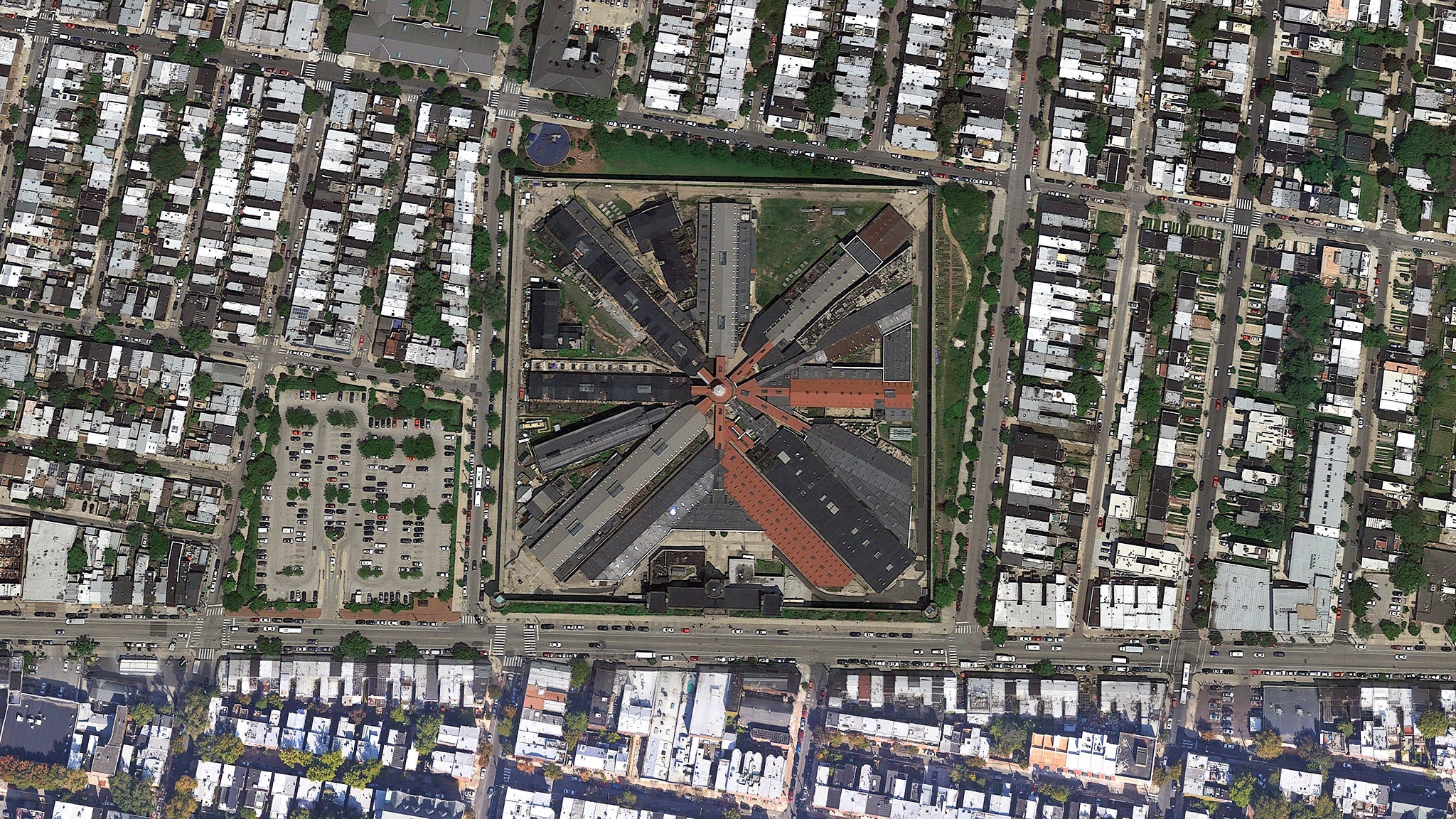
It wasn’t just the plans. Eastern State was one of the largest and most expensive public structures in the country, and each cell was outfitted with its own exercise area, running water, and central heating. And they had private flushing toilets at a time when even President Andrew Jackson was still doing his business in a White House chamber pot.
The “who’s who” of Eastern State
During its operational years as a prison (1829-1971), the penitentiary was home to several infamous inmates. Its most well-known prisoner was Al Capone, America’s most famous mobster, who was sentenced to eight months at Eastern State from 1929-1930. His cell in the prison is still on display and is said to have had fine furniture, oriental rugs, and even a personal radio.
Another famous prisoner was bank robber “Slick” Willie Sutton, who spent 11 years at Eastern State. In 1945, he was one of 12 prisoners who escaped the prison via an underground tunnel that stretched for nearly 100 feet; he and his fellow escapees were recaptured within hours.
And then there’s Pep “The Cat-Murdering Dog,” the only known canine sentenced for life at Eastern State (or anywhere). Prison records reflect that Pep took a mug shot and was given an inmate number (C-2559), although PlanPhilly was unable to find records of any labor completed during his stay. He was incarcerated in 1924 for having allegedly murdered Governor Gifford Pinchot’s wife’s cat, although Ms. Pinchot told a reporter later that the murder had never occurred and the governor had simply donated Pep to the penitentiary to increase inmate morale. In any case, he became the “beloved mascot of staff and inmates [and] lived like a king at Eastern State” until his death in 1930, when he was buried on prison grounds.
Closing & Abandonment
In 1970, after multiple riots, a breakdown of the “separate system,” and thousands more prisoners than the penitentiary had ever been constructed to handle, Eastern State closed its doors. By that time, the federal government had designated Eastern State Penitentiary a national historic landmark that could not be demolished.
For the next fifteen years, the grounds remained mostly abandoned. The Philadelphia Streets Department used some ESP buildings for storage, and city caretaker Dan McCloud came by to feed a family of stray cats on the property, but vandals and neglect continued to take their toll on the aging penitentiary walls. In 1980, the city of Philadelphia took title to the historic prison, by now in a state of ruin, for just over $400,000.
In 1984, the city transferred the penitentiary to the Philadelphia Redevelopment Authority. City Hall charged the PRA with soliciting proposals from developers who could give the historic prison a second life.
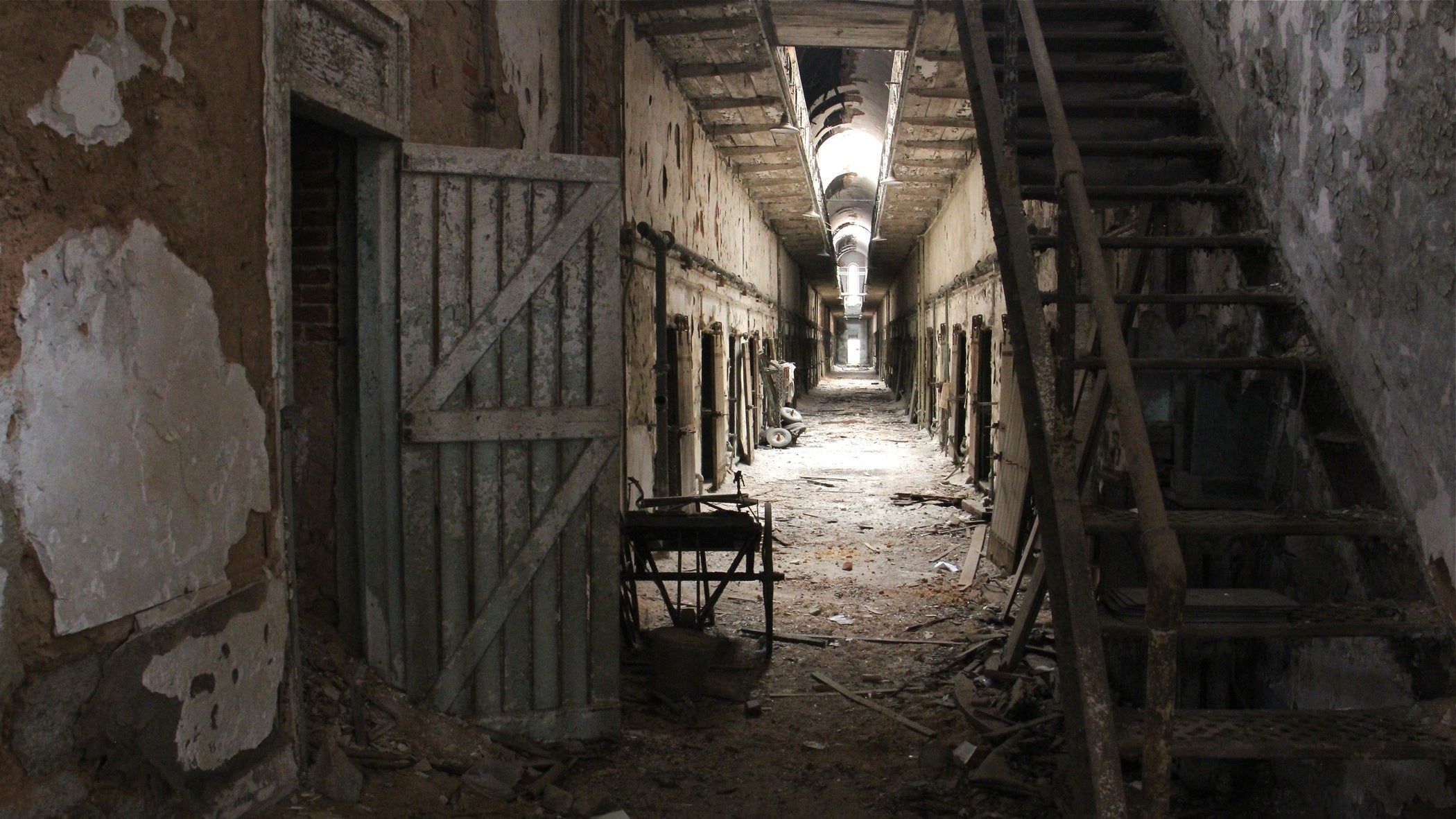
Remaking a place of punishment
Mayor Frank Rizzo had, in 1974, suggested demolishing the penitentiary and creating a criminal justice center in its place. The city didn’t do that. Ten years later, a local landscape architecture firm approached redevelopment officials with a bid to turn the cell blocks into 238 luxury apartments. The city didn’t do that, either.
It was in 1987 that redevelopment officials began to seriously consider several proposals: one for a shopping center, another for a series of retail stores and parking, another for a combination of high-priced apartments, restaurants. Another developer proposed a nightclub.
Some communities wanted one proposal. Some fought for another. And a small group of historians, architects, and preservationists formed to lobby Mayor Wilson Goode completely away from development and towards stabilization of the historic building. They called themselves the Eastern State Task Force — and they won.
“The neighborhood was just starting renewal, and there were… many ideas [for redevelopment,” said Sally Elk, who at the time acted as a liaison between the task force and the city’s historic commission. “But nothing that came up was viable in terms of preserving the radial plan, which was the most significant in terms of architecture.”
The Redevelopment Authority rejected all bids for the property and chose to move towards preservation. And with the help of generous funding from The Pew Charitable Trust and the Getty Foundation, the task force moved forward to assess the property and study possibilities for its future.
“It turned out the buildings were viable, but they needed protection,” Elk said. By then, the prison had been abandoned for decades. “Inside was like an urban forest — trees, birds, this colony of cats.”
Once the decision was made to save the building, she added, the city was a patient partner in the process. In 1991, they began the process of stabilization and preservation and held their first Halloween fundraiser, a sort of pre-iteration of Terror Behind the Walls. That first Halloween event raised money for a daytime tour program. In 1994, the penitentiary opened for tours on a daily basis. By 2000, the tours were regular and a nonprofit had formed around preserving both the history and the physical building of Eastern State.
Now, nearly 20 years later, the penitentiary has become a nationally-acknowledged museum with an ever-relevant mission: interpreting the legacy (and the failures) of the American criminal justice system. And it’s much more than an abandoned ruin or a seasonal attraction.
Elk attributes its success to a kind of optimism that she and her colleagues share, powered by history in the prison walls that’s far more powerful than terror.
“I was part of the group of people that really believed that this place had amazing potential,” Elk said. “I came on as executive director in 2000, and the whole time — I can’t explain it — it’s just a really compelling place.”
That optimism is justified. The penitentiary’s already surpassed any dreams she or the early task force may have had. “Early on, the people who were working on this thought we could attract, maybe 250,000 people [annually],” she said. “We’re at 285,000 now.”
She pauses.
“And we aren’t stopping.”
Disclosure: Hannah Chinn worked during Halloween of 2019 as a part-time seasonal actor for Terror Behind the Walls at Eastern State.
WHYY is your source for fact-based, in-depth journalism and information. As a nonprofit organization, we rely on financial support from readers like you. Please give today.




